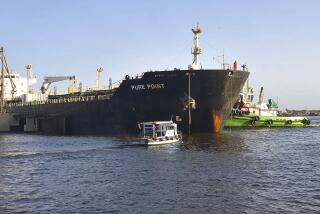Bush’s Oil Plan Pours $3 Billion Down a Deep Hole
- Share via
The Bush administration is busy burying $3 billion underground -- the cost of filling the Strategic Petroleum Reserve to its 700-million barrel capacity -- without any good reason. Moreover, it is filling the reserve with $30-per-barrel oil, contributing in part to the increase in the price of oil.
The recent European Union announcement that it will create its own reserve proves the political appeal of the policy but does nothing to reduce the problems associated with burying oil without a plan on how to use it. I see no plausible scenario in which the $3 billion in additional reserves provides meaningful economic or security benefits.
The reserve is already large enough to serve as a “strategic” reserve that can respond to physical supply disruptions related to acts of war or terrorism. But it is unlikely ever to be large enough to counter a catastrophic interruption in the supply of Persian Gulf oil or to be an “economic” reserve that might counter the Organization of the Petroleum Exporting Countries’ exercise of market power to increase oil prices.
The Energy Department now can release up to 4.1 million barrels of crude oil per day for nearly five months, an amount sufficient to respond to nearly any terrorist event or war that temporarily interrupts oil supplies.
For example, in January 1991, during the Gulf War, the first Bush administration placed 33 million barrels of the reserve’s oil on sale, but the market purchased only 16 million.
However, today’s reserve is far too small and probably could never be made large enough to respond meaningfully to a catastrophic loss of oil resulting from a crisis involving a long-term interruption in the flow of Gulf oil.
Likewise, the reserve is never likely to be large enough to work well as an economic reserve that could moderate the price of oil. When oil prices jump, it’s usually because OPEC producers, led by Saudi Arabia, have cut production to increase prices.
Yet as easily as we can release oil from the reserve in response to their exercise of market power, OPEC can simply cut output further. Since OPEC’s pockets are deeper than our reserves, we could run out of oil before OPEC runs out of money.
International reserves held by industrialized countries, which might be expanded by a new European reserve, would be inadequate to work as an economic reserve. Coordinating international reserves to allow a more forceful response to OPEC’s exercise of market power would require a nearly impossible consensus about what constitutes a “reasonable” price for oil.
When the reserve was created in 1975, its use was an afterthought. We simply presumed that its mere existence would protect us from OPEC. But oil has since become freely available on commodity markets. Today, all “supply shortages” are reflected immediately in the price of oil.
Although White House spokesman Ari Fleischer has indicated that the reserve would not be used in response to high prices, there is no scenario in which the administration could tap the reserve without prices having risen.
Even in the event of a supply interruption, using the reserve could undermine price incentives to increase production elsewhere, a realization that led the first Bush administration not to release oil from the reserve when Iraq invaded Kuwait in 1990.
Without better understanding and clear agreement on how to use the Strategic Petroleum Reserve, it is a mistake to spend $3 billion to enlarge it. The administration should carefully study how we expect the reserve to function and what policy we expect it to serve. Only then should the president determine its size.
In the unlikely event that the Bush administration can explain how the Strategic Petroleum Reserve might work as an economic reserve, then it certainly will need to be larger. But a credible analysis is more likely to determine that the reserve is only viable as a “strategic” reserve, in which case the current one is large enough.
Ronald E. Minsk, an attorney in Washington, was a special assistant to President Clinton for economic policy in 2000 and 2001.
More to Read
Get the L.A. Times Politics newsletter
Deeply reported insights into legislation, politics and policy from Sacramento, Washington and beyond. In your inbox twice per week.
You may occasionally receive promotional content from the Los Angeles Times.










